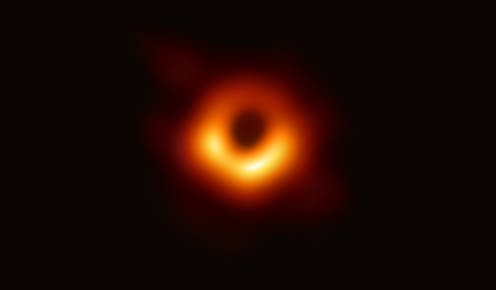A unique collaboration using a virtual Earth-sized telescope shows how science is changing in the 21st century
- Written by Sophie Ritson, Research Strategy Project Officer, The University of Melbourne

In 2019, the Event Horizon Telescope (EHT) collaboration produced the first-ever image of a black hole, stunning the world.
Now, scientists are taking it further. The next generation Event Horizon Telescope (ngEHT) collaboration aims to create high-quality videos of black holes.
But this next-generation collaboration is groundbreaking in other ways, too. It’s the first large physics collaboration bringing together perspectives from natural sciences, social sciences and the humanities.
A virtual telescope spanning the planet
The larger a telescope, the better it is at seeing things that look tiny from far away. To produce black hole images, we need a telescope almost the size of Earth itself. That’s why the EHT uses many telescopes and telescope arrays scattered across the globe to form a single, virtual Earth-sized telescope. This is known as very long baseline interferometry.
Harvard astrophysicist Shep Doeleman, the founding director of the EHT, has likened this kind of astronomy to using a broken mirror. Imagine shattering a mirror and scattering the pieces across the world. Then you record the light caught by each of these pieces while keeping track of the timing, and collect those data in a supercomputer to virtually reconstruct an Earth-sized detector.
The 2019 first-ever image of a black hole was made by borrowing existing telescopes at six sites. Now, new telescopes at new sites are being built to better fill in the gaps of the broken mirror. The collaboration is currently in the process of selecting optimal places across the world, to increase the number of sites to approximately 20.
This ambitious endeavour needs over 300 experts organised into three technical working groups and eight science working groups. The history, philosophy and culture working group has just published a landmark report outlining how humanities and social science scholars can work with astrophysicists and engineers from the first stages of a project.
The report has four focus areas: collaborative knowledge formation, philosophical foundations, algorithms and visualisation, and responsible telescope siting.
How can we all collaborate?
If you’ve ever tried to write a paper (or anything!) with someone else, you know how difficult it can be. Now imagine trying to write a scientific paper with over 300 people.
Should one expect each author to believe and be willing to defend every part of the paper and its conclusions? How should we all determine what will be included? If everyone has to agree with what is included, will this result in only publishing conservative, watered-down results? And how do you allow for individual creativity and boundary-pushing science (especially when you are attempting to be the first to capture something)?
To resolve such questions, it’s important to balance collaborative approaches and structure everyone’s involvement in a way that promotes consensus, but also allows people to express dissent. Diversity of beliefs and practices among collaboration members can be beneficial to science.
How do we visualise the data?
The aesthetic choices regarding the final black hole images and videos take place in a broader context of visual culture.
In reality, blue flames are hotter than flames appearing orange or yellow. But in the above false-colour image of Sagittarius A* – the black hole at the centre of the Milky Way – the colour palette of orange-red hues was chosen as it was believed orange would communicate to wider audiences just how hot the glowing material around the black hole is.
This approach connects to historical practices of technology-assisted scientific images, such as those by Galileo, Robert Hooke, and Johannes Hevelius. These scientists combined their early telescopic and microscopic images with artistic techniques so they would be legible to non-specialist audiences (particularly those who did not have access to the relevant instruments).
How philosophy can help
Videos of black holes would be of significant interest to theoretical physicists. However, there is a bridge between formal mathematical theory and the messy world of experiment where idealised assumptions often do not hold up.
Philosophers can help to bridge this gap with considerations of epistemic risk – such as the risk of missing the truth, or making an error. Philosophy also helps to investigate the underlying assumptions physicists might have about a phenomenon.
For example, one approach to describing black holes is called the “no-hair theorem”. It’s the idea that an isolated black hole can be simplified down to just a few properties, and there’s nothing complex (hairy) about it. But the no-hair theorem applies to stable black holes. It relies on an assumption that black holes eventually settle down to a stationary state.
Read more: What would happen if Earth fell into a black hole?
Responsible telescope siting
The choice of locations for telescopes, or telescope siting, has historically been determined by technical and economic considerations – including weather, atmospheric clarity, accessibility and costs. There has been a historic lack of consideration for local communities, including First Nations peoples.
As the struggle at Mauna Kea in Hawai'i highlights, scientific collaborations are obligated to address ethical, social and environmental considerations when siting.
The ngEHT aims to advance responsible siting practices. It draws together experts in philosophy, history, sociology, community advocacy, science, and engineering to contribute to the decision-making process in ways that include cultural, social and environmental factors when choosing a new telescope location.
Overall, this collaboration is an exciting example of how ambitious plans demand innovative approaches – and how sciences are evolving in the 21st century.
Authors: Sophie Ritson, Research Strategy Project Officer, The University of Melbourne





